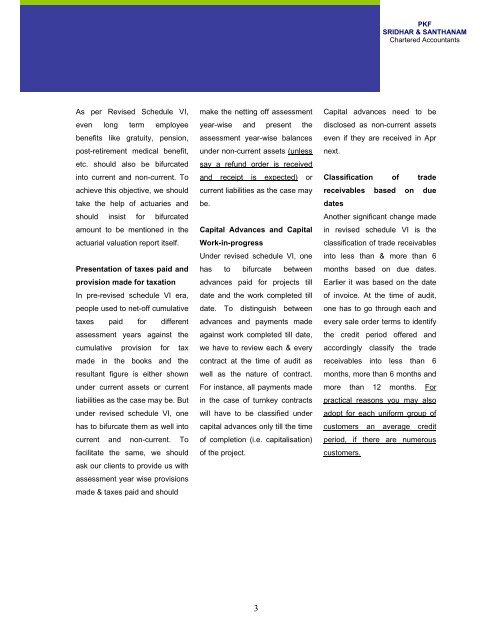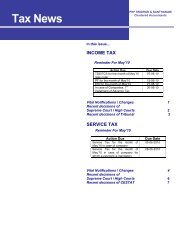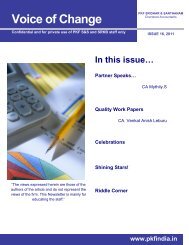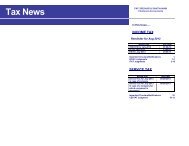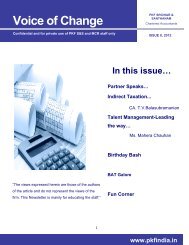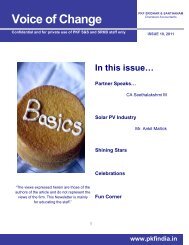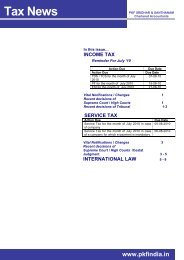Newsletter Issue No 7-15th July 2012 - PKF Sridhar & Santhanam
Newsletter Issue No 7-15th July 2012 - PKF Sridhar & Santhanam
Newsletter Issue No 7-15th July 2012 - PKF Sridhar & Santhanam
You also want an ePaper? Increase the reach of your titles
YUMPU automatically turns print PDFs into web optimized ePapers that Google loves.
<strong>PKF</strong><br />
SRIDHAR & SANTHANAM<br />
Chartered Accountants<br />
As per Revised Schedule VI,<br />
even long term employee<br />
benefits like gratuity, pension,<br />
post-retirement medical benefit,<br />
etc. should also be bifurcated<br />
into current and non-current. To<br />
achieve this objective, we should<br />
take the help of actuaries and<br />
should insist for bifurcated<br />
amount to be mentioned in the<br />
actuarial valuation report itself.<br />
Presentation of taxes paid and<br />
provision made for taxation<br />
In pre-revised schedule VI era,<br />
people used to net-off cumulative<br />
taxes paid for different<br />
assessment years against the<br />
cumulative provision for tax<br />
made in the books and the<br />
resultant figure is either shown<br />
under current assets or current<br />
liabilities as the case may be. But<br />
under revised schedule VI, one<br />
has to bifurcate them as well into<br />
current and non-current. To<br />
facilitate the same, we should<br />
ask our clients to provide us with<br />
assessment year wise provisions<br />
made & taxes paid and should<br />
make the netting off assessment<br />
year-wise and present the<br />
assessment year-wise balances<br />
under non-current assets (unless<br />
say a refund order is received<br />
and receipt is expected) or<br />
current liabilities as the case may<br />
be.<br />
Capital Advances and Capital<br />
Work-in-progress<br />
Under revised schedule VI, one<br />
has to bifurcate between<br />
advances paid for projects till<br />
date and the work completed till<br />
date. To distinguish between<br />
advances and payments made<br />
against work completed till date,<br />
we have to review each & every<br />
contract at the time of audit as<br />
well as the nature of contract.<br />
For instance, all payments made<br />
in the case of turnkey contracts<br />
will have to be classified under<br />
capital advances only till the time<br />
of completion (i.e. capitalisation)<br />
of the project.<br />
Capital advances need to be<br />
disclosed as non-current assets<br />
even if they are received in Apr<br />
next.<br />
Classification of trade<br />
receivables based on due<br />
dates<br />
Another significant change made<br />
in revised schedule VI is the<br />
classification of trade receivables<br />
into less than & more than 6<br />
months based on due dates.<br />
Earlier it was based on the date<br />
of invoice. At the time of audit,<br />
one has to go through each and<br />
every sale order terms to identify<br />
the credit period offered and<br />
accordingly classify the trade<br />
receivables into less than 6<br />
months, more than 6 months and<br />
more than 12 months. For<br />
practical reasons you may also<br />
adopt for each uniform group of<br />
customers an average credit<br />
period, if there are numerous<br />
customers.<br />
3<br />
www.pkfindia.in


